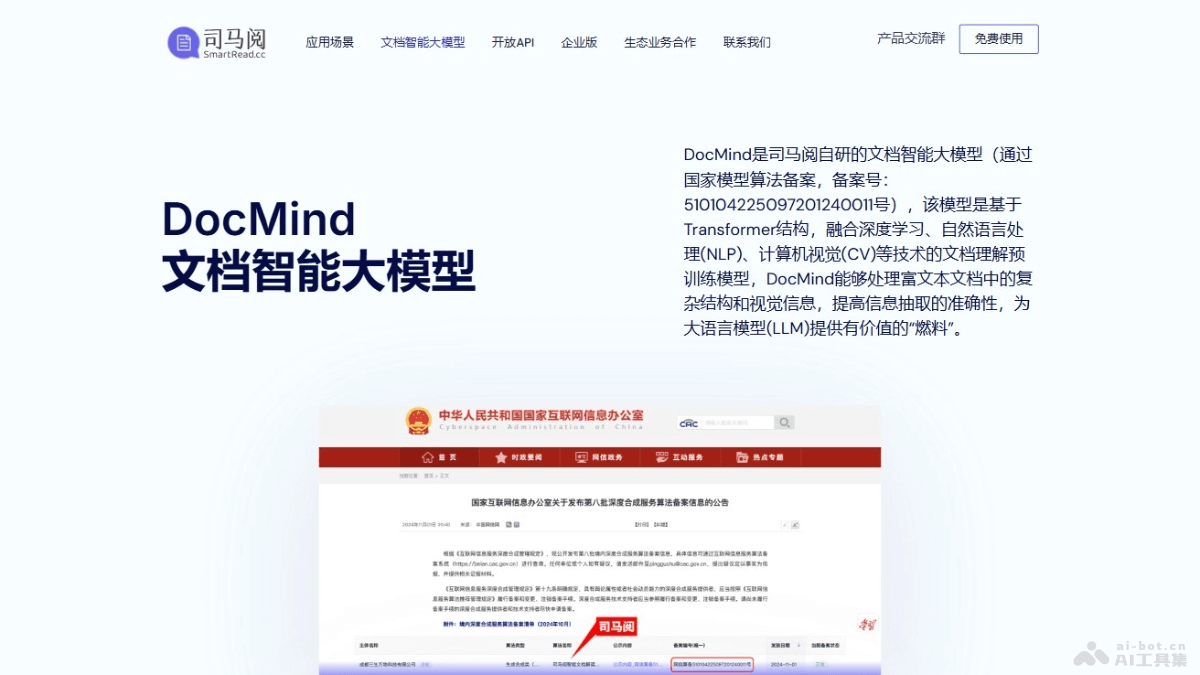DocMind
by SmartReadDocMind is a document intelligence model by SmartRead, leveraging Transformer architecture, deep learning, NLP, and CV to process complex document structures and visual information, enhancing information extraction accuracy.
What is DocMind?
DocMind is a document intelligence model developed by SmartRead, based on the Transformer architecture, integrating deep learning, NLP, and CV technologies. It handles complex structures and visual information in rich-text documents, improving the accuracy of information extraction. DocMind supports precise identification of document entities, capturing text dependencies, and deep understanding of document content. It integrates with knowledge bases to enhance the understanding of professional documents and automates tasks like Q&A, document classification, and organization, applicable in fields like law, education, and finance.
Main Features of DocMind
- Information Extraction: Accurately identifies various entities in documents, such as names of people, places, and organizations, and determines the relationships between these entities. It quickly locates important data in complex documents, integrates multimodal information, and ensures that the extracted information is comprehensive and accurate.
- Feature Representation: Captures long-distance dependencies in the text, generating precise vector representations for each word that fully consider the context. DocMind combines text and visual information to create rich and comprehensive feature vectors for document elements, deeply understanding the hierarchical structure of documents.
- Content Understanding: Performs in-depth semantic analysis of document content, uncovering the true meaning behind the text, clearly grasping the overall structure and logical flow of the document, and understanding the interrelationships and importance of different parts.
- Knowledge Integration: Deeply integrates with domain-specific knowledge bases, significantly enhancing the understanding of professional documents. DocMind uses common sense and background knowledge to assist in understanding document content, making reasonable assumptions and inferences.
- Task Execution: Automatically performs document-based tasks such as natural language Q&A, providing answers, document classification, and organization, improving work efficiency. It has the ability for continuous learning, optimizing its performance through incremental learning.
Technical Principles of DocMind
- Transformer Architecture: Based on the Transformer architecture, a deep learning model suitable for processing sequence data such as text. It captures long-distance dependencies in sequences using a self-attention mechanism.
- Multimodal Fusion: Integrates text and visual information, using multimodal fusion technology to process complex documents containing images, tables, and text, providing a more comprehensive understanding of documents.
- Pre-training Technology: Uses pre-training technology, learning from a large number of unlabeled documents and transferring information to downstream tasks, improving the accuracy of information extraction.
- Local Invariance Features: Analyzes the local invariance features of document layouts, helping the model maintain stable performance across different document layouts.
- Contextual Understanding: When generating vector representations for each word, DocMind fully considers contextual information, providing more precise feature representations.
- Hierarchical Structure Understanding: Processes multi-level feature extraction from words to paragraphs to entire documents, understanding the hierarchical structure of documents.
Application Scenarios of DocMind
- Laws and Regulations: Processing and analyzing a large number of legal documents, such as contracts and regulations, for organization, parsing, and archiving. Supports legal affairs and compliance management.
- Bidding and Tendering: Organizing and parsing bidding documents, extracting key information and conditions. Intelligently evaluates bidding opportunities and the level of bidding projects.
- Academic Education: Processing academic papers and literature, conducting literature reviews, citation analysis, and knowledge integration. Supports academic research and writing.
- Manufacturing: Intelligent organization and analysis of various documents such as production plans, technical specifications, and quality control. Improves production efficiency and management levels.
- Financial Risk Control: Processing compliance documents, review reports, and risk assessment reports. Supports compliance risk control and internal audits.
Model Capabilities
Model Type
multimodal
Supported Tasks
Information Extraction
Document Classification
Q&a
Knowledge Integration
Task Automation
Tags
Document Intelligence
NLP
CV
Transformer
Deep Learning
Information Extraction
Knowledge Integration
Task Automation
Multimodal Fusion
Professional Documents
Usage & Integration
Screenshots & Images
Additional Images

Stats
127
Views
0
Favorites
